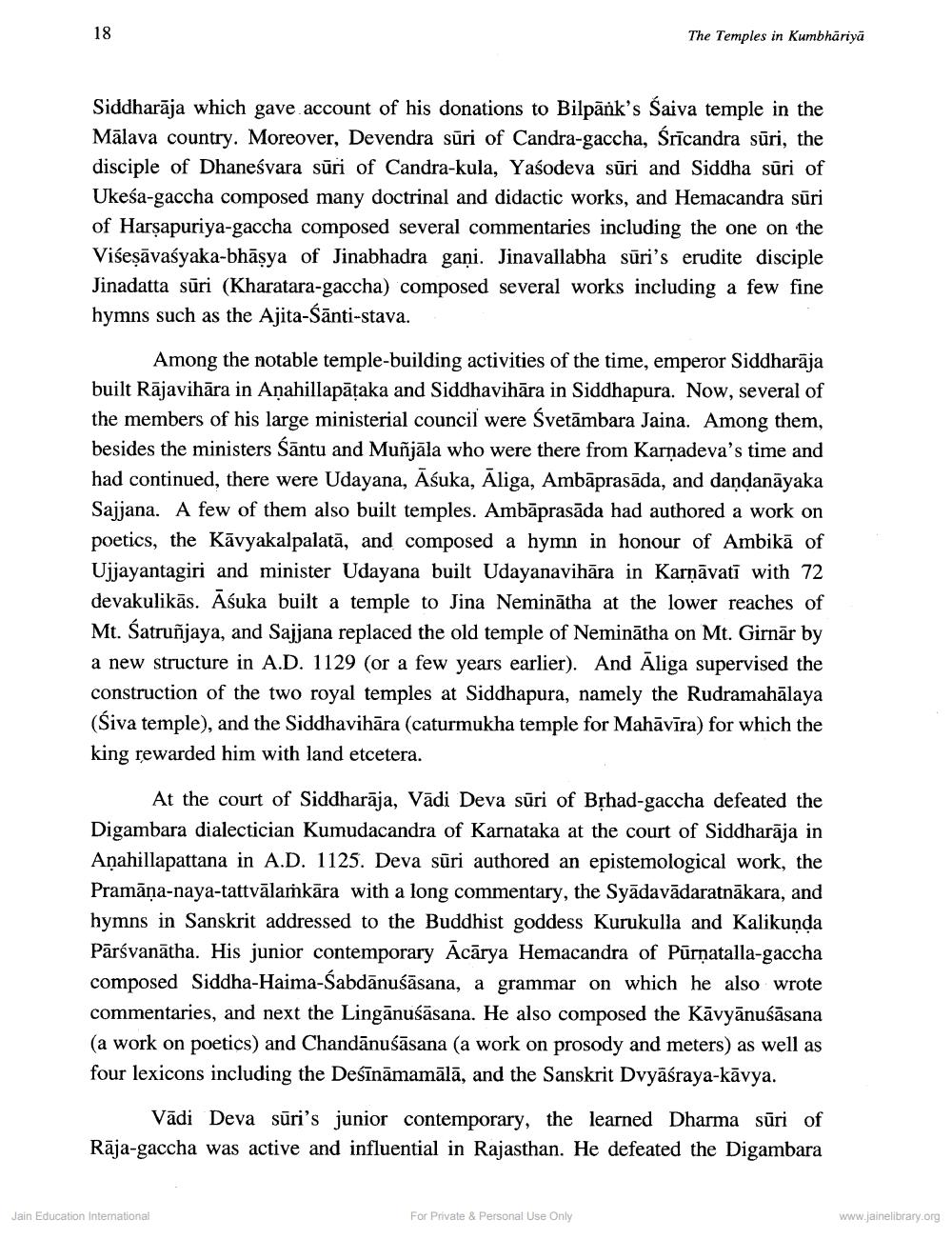________________
The Temples in Kumbhariya
Siddharāja which gave account of his donations to Bilpānk's Saiva temple in the Mālava country. Moreover, Devendra sūri of Candra-gaccha, Sricandra sūri, the disciple of Dhaneśvara sūri of Candra-kula, Yaśodeva sūri and Siddha sūri of Ukeśa-gaccha composed many doctrinal and didactic works, and Hemacandra sūri of Harsapuriya-gaccha composed several commentaries including the one on the Višeşāvaśyaka-bhāșya of Jinabhadra gani. Jinavallabha sūri's erudite disciple Jinadatta sūri (Kharatara-gaccha) composed several works including a few fine hymns such as the Ajita-Sānti-stava.
Among the notable temple-building activities of the time, emperor Siddharāja built Rājavihāra in Anahillapāțaka and Siddhavihāra in Siddhapura. Now, several of the members of his large ministerial council were Svetāmbara Jaina. Among them, besides the ministers Sāntu and Muñjāla who were there from Karnadeva's time and had continued, there were Udayana, Āśuka, Aliga, Ambāprasāda, and dandanāyaka Sajjana. A few of them also built temples. Ambāprasāda had authored a work on poetics, the Kāvyakalpalatā, and composed a hymn in honour of Ambikā of Ujjayantagiri and minister Udayana built Udayanavihāra in Karņāvatī with 72 devakulikās. Āśuka built a temple to Jina Neminātha at the lower reaches of Mt. Satruñjaya, and Sajjana replaced the old temple of Neminātha on Mt. Girnār by a new structure in A.D. 1129 (or a few years earlier). And Aliga supervised the construction of the two royal temples at Siddhapura, namely the Rudramahālaya (Śiva temple), and the Siddhavihāra (caturmukha temple for Mahāvīra) for which the king rewarded him with land etcetera.
At the court of Siddharāja, Vādi Deva sūri of Brhad-gaccha defeated the Digambara dialectician Kumudacandra of Karnataka at the court of Siddharāja in Anahillapattana in A.D. 1125. Deva sūri authored an epistemological work, the Pramāņa-naya-tattvālamkāra with a long commentary, the Syādavādaratnākara, and hymns in Sanskrit addressed to the Buddhist goddess Kurukulla and Kalikunda Pārsvanātha. His junior contemporary Acārya Hemacandra of Pūrņatalla-gaccha composed Siddha-Haima-Sabdānuśāsana, a grammar on which he also wrote commentaries, and next the Lingānuśāsana. He also composed the Kāvyānuśāsana (a work on poetics) and Chandānuśāsana (a work on prosody and meters) as well as four lexicons including the Deśīnāmamālā, and the Sanskrit Dvyāśraya-kāvya.
Vādi Deva sūri's junior contemporary, the learned Dharma sūri of Rāja-gaccha was active and influential in Rajasthan. He defeated the Digambara
Jain Education International
For Private & Personal Use Only
www.jainelibrary.org




